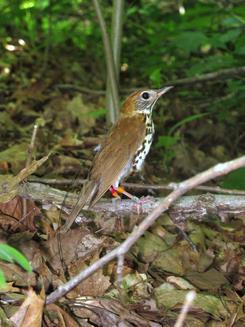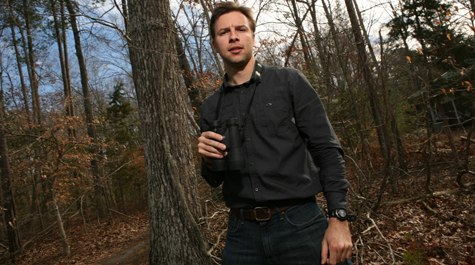Stalking the sweet-singing, reclusive wood thrush
The wood thrush’s song is one of the most beautiful among eastern birds, and its flute-like warble is one of the reasons Vitek Jirinec picked this species to study.
“It’s a charismatic species,” he said. “Even the lay public knows about wood thrushes because of their beautiful song. Oftentimes its song is described as the symbol of upcoming spring in the eastern U.S. population. Unfortunately it’s been declining over the last 50 years.”
Jirinec is a master’s student in William & Mary’s Department of Biology. His work on wood thrushes and their microhabitat was recognized at the College of Arts & Sciences Graduate Research Symposium, a March 20-21 event that both showcased and honored excellence in research by graduate students at William & Mary. His investigations of wood thrush microhabitat and the effects of human-modified landscapes on the health of the species won the Northrup Grumman Corporate Award, one of several honors to be presented at an awards luncheon at the symposium.
In mid-March Jirinec was finishing up his master’s thesis on wood thrush microhabitat, the culmination of several years of studying the birds with his advisor, Matthias Leu, associate professor of biology. Jirinec said the “eee-oh-wee” trill of the wood thrush is familiar to many people who wouldn’t be able to identify the species either by song or by sight.
“It sounds like a soloist playing the flute off in the woods. The wood thrush is known for being able to sing at least two different notes at one time. It’s this eerie, flute-like song. You can hear it usually early in the morning, but also right before it gets dark,” Jirinec said. Sometimes in the evening, he added, the wood thrush is the only thing you hear in the forest, besides the bugs.
There’s more to this bird than a pretty song, though. The wood thrush likes to live in patches of deciduous forest, Jirinec said, so it can be used as an indicator species for the health of the environment. It’s related to the robin, but you aren’t likely to find a wood thrush in the middle of a grassy space. Jirinec said the wood thrush likes to forage around on the forest floor, a habit that tends to keep it out of human sight, much like the aptly named hermit thrush, another relative.
 “The Latin name really describes these birds. It’s Hylocichla mustelina. It means woodland thrush-weasel,” Jirinec explained. “It describes just how elusive these birds are, mostly because of their shyness and coloration.”
“The Latin name really describes these birds. It’s Hylocichla mustelina. It means woodland thrush-weasel,” Jirinec explained. “It describes just how elusive these birds are, mostly because of their shyness and coloration.”
Jirinec set out to study how individual birds relate to their home ranges. He said wood thrushes will migrate into the U.S. from Central America in mid-April. They are here to breed, and the males will go about setting themselves up as proprietor of a home range that might be a few acres across. Jirinec is interested in finding out what landscape features draw—and hold—wood thrushes. Conventional ornithological wisdom held that the wood thrushes require large, mature forested areas, but the birds seem to do well in the patchy woodlands of the Virginia Peninsula.
“They’re associated with the forest, but people have been seeing them in their back yards,” he explained. “We want to figure out what they need in the environment.”
Location, location, location: When it comes to real estate, the woodland thrush-weasel likes a nice, tangled place with lots of dead leaves underfoot, Jirinec said. They scratch around, kicking up the leaves for food, dining on “ticks, worms, insects, any sort of invertebrate,” he added. Presence of snags—upright dead trees—is a bonus in wood thrush real estate, and Jirinec said that the birds seem to have preference for certain tree species.
Jirinec tracked a total of 47 wood thrushes on the Peninsula. His sample consisted of 37 males and 10 females. He said the females were a lot harder to capture. To collect his birds, he set up mist nets—imagine volleyball nets with very fine mesh—in likely wood thrush habitat. He caught lots of birds this way, but they were all males.
“The males are very territorial,” he explained. “I can go out to the woods and set up a mist net, then I have a speaker and I play the wood thrush song. A male thinks another male is moving into his territory, and he comes out to deal with the intruder and, boom, he gets caught in my net.”
The female wood thrushes lack the territorial instinct, and so are immune to Jirinec’s aural lure. To catch the lady thrushes, he had to resort to canopy nets some six meters high and a dozen meters across, capturing the females more or less at random near the nests of his males. He banded all the birds, but the usual ornithologist’s color-code scheme was only of limited use for tracking the reclusive wood thrushes.
“To be able to follow individual birds we have to attach a little transmitter on each bird. These transmitters are tiny; it’s like a little backpack sitting on the rump of the bird,” he said. “The whole thing weighs maybe three percent of the body weight of the birds, so it’s really tiny. They last about 60 days; that’s how long we have to track these birds.”
If Jirinec were studying eagles or other large birds, he would have fit his specimens with solar-powered, satellite-linked transmitters that could track each bird’s progress in real time and map it on a web site. The little fanny packs on his wood thrushes aren’t nearly that powerful, so Jirinec uses radio telemetry.
“Each bird gets its own frequency,” he explained. “So we can dial in that frequency to a receiver and use a directional antenna to find out where that signal is coming from.”
Thrush location by radio telemetry means working the woods with a breadbox-sized receiver, a GPS unit and threading that antenna through the trees.
It’s a work-intensive method, and Jirinec got assistance from 16 undergraduate students, notably Akshay Deverakonda ’15 who was conducting his senior honors research in biology on home range overlap of wood thrush pairs.
Jirinec said he assumed that the shy wood thrushes would be homebodies, rarely straying from the patch they’ve claimed. A few days in the woods made him revise his thinking.
“I thought they did not move. I said, I’m gonna go out in the forest and catch that bird and it’s gonna stay right there for the rest of the summer,” Jirinec explained. “But what we found out is that 56 percent of the birds actually move their territory, usually after something eats their nest.”
With the assistance of a number of undergraduate volunteers, Jirinec was able to find the new homes of most of the birds, but the relocation brought him some new and unforeseen challenges.
“I have a permit to work in New Quarter Park,” he explained. “So I catch a bird in New Quarter Park and my bird decides to fly to Camp Peary.”
New Quarter Park is less than a minute from Camp Peary as the thrush flies, but Camp Peary is a Central Intelligence Agency facility. Access for a guy who plans on roaming around with a big antenna and a beeping blue box is unlikely.
Jirinec had better luck chasing birds that flew onto the grounds at the Naval Weapons Station Yorktown, where the personnel are used to William & Mary researchers working on the grounds.
“I talked them into letting me work there. They did a background check on me. They gave me a ‘restricted area’ badge,” Jirinec said. “I was surprised. I had a harder time getting permission to work in Waller Mill Park than the Naval Weapons Station.”
One of the undergraduates working with Jirinec pursued a bird into the back yard of a Williamsburg home. The homeowner spotted a young guy stalking through the property, slowly waving an antenna. The man looking out his back window was Scott Nelson, Legum Professor of History at William & Mary, and in a former life, an IT guy. Nelson remembers going out the back door to investigate.
“I asked him if he was wardriving,” Nelson said, using a hacker’s term for hunting a vulnerable wifi connection. “He didn’t know what I was talking about.”
The thrush in Nelson’s yard added to a set of data that documents how much time each bird spent in each section of its home range, Jirinec explained.
“We then go back to each habitat and take samples, measuring various aspects of the trees, such as diameter,” he said. “We evaluate what’s on the ground—leaf litter or needle cover? And we take food samples.”
Jirinec picked up and processed 370 items from the wood thrush menu—ticks, earthworms, spiders—their location pinpointed by GPS. He’s using the bird location surveys, habitat evaluations and food samples to put together an understanding of how the wood thrush population is faring in various landscapes.
He said it’s too early to talk about final results of his work, but doesn’t mind discussing preliminary findings. The wood thrushes seem to gravitate to areas that have the highest invertebrate biomass, in other words, where food is most plentiful. It sound like a no-brainer, but Jirinec says that there is no good way to identify a particularly food-rich area by just looking at the landscape and so this data might suggest that the thrushes devote considerable time to scoping out potential home sites.
When it comes to real estate choice, the wood thrush wants a wooded area, but Jirinec’s data doesn’t entirely support earlier concepts that indicate that the species will only live in deep woods, and like to be away from humans. For the thrushes in Jirinec’s study, the quality of their woody home patches seems to be at least as important as the quantity, the size of available territory. Jirinec found that his birds like a more mature forest and a high canopy level, for example, and he pointed out that such features can often be found even in developed areas, away from the deep forest.
“It’s too simplistic to say: fragmented landscape, bad for the birds,” Jirinec said. “Let’s see exactly what they need in there, and then if those features are missing from the fragmented landscape, then we can say that’s it’s bad for the birds.”
















